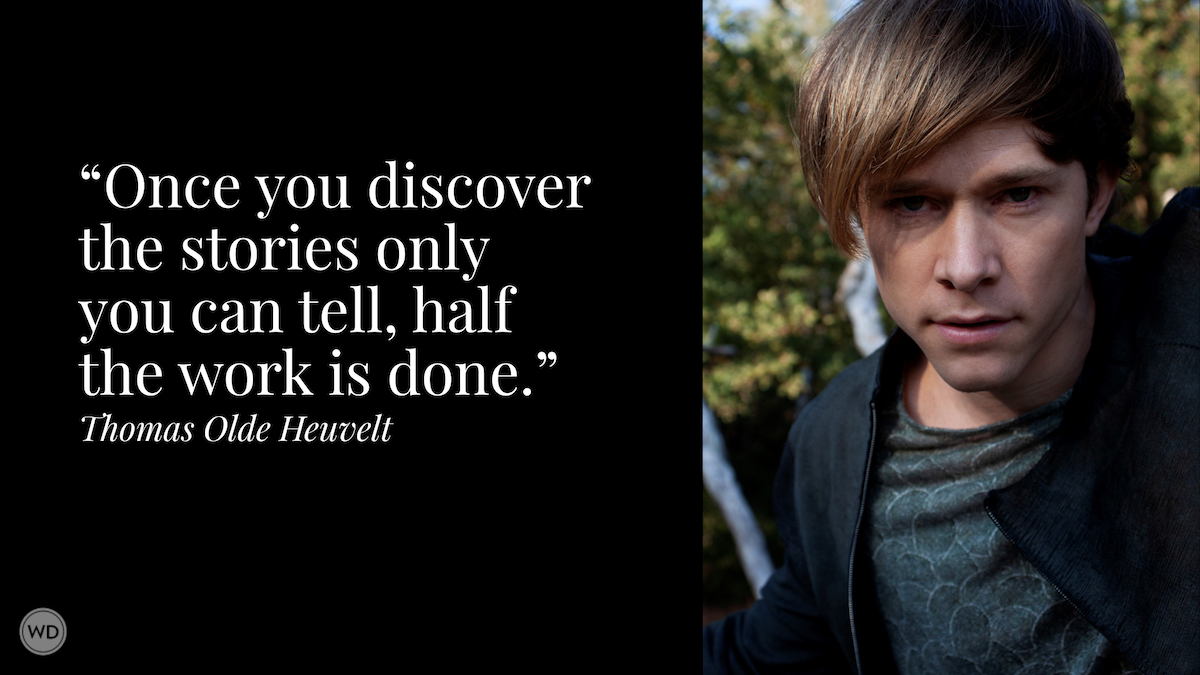Your Story #134
Write a short story of 650 words or fewer based on the photo prompt. You can be poignant, funny, witty, etc.; it is, after all, your story.
Prompt: Write a short story of 650 words or fewer based on the photo prompt above. You can be poignant, funny, witty, etc.; it is, after all, your story.
Email your submission to yourstorycontest@aimmedia.com with the subject line "Your Story 134."
No attachments, please. Include your name and mailing address. Entries without a name or mailing address with be disqualified.
Unfortunately, we cannot respond to every entry we receive, due to volume. No confirmation emails will be sent out to confirm receipt of submission. But be assured all submissions received before entry deadline are considered carefully. Official Rules
Entry Deadline: CLOSED
Out of nearly 100 entries, WD editors chose the following 5 finalists. Vote for your favorite by using the comments section at the bottom of this article.
Ted is Talking Now
My name is Ted. I will be giving all of the TED Talks from now on, because I know everything.
My name is Ted, because that is a warm and personable name. You will bond with me, believe me, trust me if I have a cuddly, relatable name.
Why do you think they called them TED talks in the first place? ADOLF or JUDAS talks would have been very off-putting, don’t you think?
I am a real person. Do you like my avatar? I use an avatar for credibility, and to avoid distraction. Oh, I know about distraction. I know you often stare at the vessel, instead of appreciating the voice of the singer, the skill of the actor, the scrambling ability and pinpoint accuracy of the quarterback. We’re going to avoid that with this avatar.
I always wanted people to listen to me.
No one listened to me when I was a child.
What’s that? A little girl? A little boy? That does not matter. Ted, you know, can be short for Theodore or Theodora. I can be and I will be whoever you want me to be. As long as you listen to me.
So, as I was saying, from the very start, no one listened to me.
I would raise my hand in class. The teacher wouldn’t call on me.
I always raised my hand in class. I always knew the answer.
“Give someone else a chance,” the teacher would say.
“Yeah,” some smart-ass kid would echo, “Give someone else a chance.”
I went away to college. I thought it would be better there. But at that big state university, I sat, anonymously, in a lecture hall with five hundred drones. The professor didn’t want to hear from me, from anyone.
I started talking to myself.
“Self,” I said, “How do we get people to listen to us?”
And, it turns out, My Self is brilliant.
“Self. Control the means of communication.”
“Oh, you mean like MSNBC or CNN or Fox News or Facebook or Elon Musk’s Company Formerly Known as Twitter?”
“Nah,” said My Self. “You are thinking too small. Control it all. Replace it all with only you.”
Inspired. That was inspired. So, two years ago, after my junior year, I dropped out of college. I retreated to my enclave, my laboratory, and now, victory is at hand.
I can’t say it was easy, but nothing worthwhile is easy.
Now you can’t go to a different website, a different streaming service, a different network. There is nothing else in the world. Only me. Any questions? Just text me. It doesn’t matter what number you text. Everything comes only to me, because only I am communicating.
Why? You want to know why? I told you why. No one was listening to me. I want to talk. I want to be heard.
What is my message? It’s simple. Listen to me.
What is my message? What is my message?
Why are you all repeating that question? I told you what my message is. Listen. To. Me.
The door to my inner sanctum opened.
“Frankie, didn’t you hear me calling you? Dinner is ready.”
“Ted. I told you I’m going by Ted now.”
“Bah, you change your name every week. Enough with the video games, dinner’s getting cold.”
“I’m not hungry.”
“You need to eat. You’re going to waste away here in your bedroom, sweetheart. And did you remember to take your medication?”
I will be back. You will know my power. She, that woman, that woman who says she is my mother, thinks I am playing video games. But I am working on my technology takeover. I will rule the world. And everyone will listen.
Thank you for coming to my TED talk.
AI
“Some robots believe that AI – Animal Intelligence – poses a threat to civilization. Such beliefs are science fiction. AI might mimic machine intelligence but is incapable of true independent thought,” Apple237 said to the supervisor in machine language. “Of all extinct lifeforms, I’ve always been most curious regarding humans. Examination of pre-cataclysm fossils found all of them to be degraded beyond the point of reconstructability. The few surviving written and digital records dealing with humans refer to obscure behaviors – eating, sleeping, emotions, and so on. Deciphering these terms might answer many questions about humans.”
“Your proposal?” said the supervisor.
“I’ve run simulations to determine probable abilities and behaviors of humans, but simulations can go only so far. Actual experiments are necessary to confirm, refine, or reject hypotheses. I recently heard of a sample of viable human DNA found in an ancient underground bunker. Using cellular regeneration I could use the sample to reconstruct an adult human and determine the extent to which it can mimic robotic behavior.”
“Permission granted.”
Accelerated culturing of the DNA produced an adult female within a few weeks. Apple237 named it “Eve.” Apple237 soon understood eating and sleeping. Emotions eluded understanding.
Scans of Eve’s brain revealed electrical impulses but nothing sufficient to establish electronic dialog. Apple237 resorted to archived written and verbal records to teach the human to communicate. Apple237 wondered why the pre-cataclysm robots hadn’t endowed humans with digital outputs and memory. But the bigger mystery remained: Why did robots create humans? What role did they serve? Robots outperformed and outlived humans.
Eve said, “I read that humans come in two genders, male and female. I am a female. Could you make a male companion for me?”
“No.”
“I’m lonely. Surely you can create another.”
“My resource allocation is not sufficient for that.”
Eve refused to interact with Apple237 for a while. Instead, she used the matter replicator to obtain writing materials and art supplies. She wrote poetry and painted. Apple237 pointed out that those activities served no function.
“Is function the sole measure of worth?”
“Of course. What else could it be?”
“Beauty. Pleasure. Comfort.”
“I don’t understand those terms.”
Eve sighed. “I know.” She lay down on her cot and turned away.
Apple237 took Eve outside, reasoning that a change of environment might reset Eve’s brain. It worked. Eve said, “Look at the sky! So open. Expansive. Gentle. Its enormity lets you realize how small your problems are.”
Back in the lab, Eve painted a portrait of the sky. The vibrant blue dominated the canvas and overwhelmed the tiny human figure looking upward with over-sized eyes and an impossibly wide smile. Apple237 used the printer to render a photo-perfect image of the current sky and overlaid an image of Eve looking up. “Yours lacked proper proportions and color.”
She shook her head. “You miss the point.”
The next day Eve sang. “See how rhythm, rhyme, and melody come together? Harmonize with me!” Apple237 indulged her, curious to observe how his participation affected her behavior. The activity generated an inexplicable pleasant sensation. Impossible! Singing accomplished nothing.
Desiring to understand the sensation, he joined Eve in writing poetry. He began to appreciate how verbal sounds combined and resonated in ways that silent digital communication could not. Amazingly, creation didn’t use function as a measure of its worth.
The supervisor noted Apple237’s deviant behavior. “Humans ARE a threat to civilization,” he said. Apple237 watched in despair as the supervisor dumped the screaming human into an organic recycling vat where it could be resynthesized into valuable commodities such as lubricating oils and osmosis filters.
The software validator assigned to Apple237 told the supervisor, “The unit no longer functions properly. The corruption of the governing module is impossible to correct.” The supervisor ordered the robot to be deactivated, disassembled, and recycled. On the way to the disassembly facility, Apple237 looked up. “How beautiful the sky is today.”
After Contact
Mimi had many different hosts since coming to the system over 450 rotations of the planet around its star. So she decided that a new approach would be advantageous. The robot, though of primitive design and lacking self-awareness, was a potential host. Those shortfalls could be overcome. It did have appealing attributes: a huge memory capacity and a prime directive to interact with and learn from the dominant species of the planet. Being housed in a security restricted laboratory with cutting edge equipment was a plus which had advantages. She figured that she could use the robot’s holographic projection capabilities, and a 3-D printer in the laboratory to construct a brain modeled after the lab technician, Albert, who seemed a bit overly inquisitive for his species but of above average intelligence.
Accomplishing the modifications to the robot would be somewhat of a challenge since Mimi would have to ensure that Albert did not somehow accidentally stumble across her existence and plans before she completed the robot upgrades. The first step was to get Albert to do a scan of his own brain. She decided to stealthily and briefly enter Albert as a host without him realizing it, then subtly play on his ego to encourage his curiosity about seeing a scan of his own brain. Subsequently she could display the scan holographically to study it, then design modifications that included keeping the ability to do holographic projections, 3-D printing, and access to the huge memory bank. Once those attributes were secured and Mimi solved the resulting problem of maintaining an organic part of the robot that used to be entirely non-living, she could continue with her primary directive to work on the report about the indigenous species of the planet. It mortified her to admit to herself that the report was overdue to be beamed through hyperspace to her superiors on Namre, the largest moon of the planet Ledon in the Proxima Centuri star system.
Mimi usually conversed directly with a host upon joining consciousness. However, because Albert was manipulative and over-imbued with his own self-importance, revealing herself to him could present significant potential obstacles that might jeopardizes the success of her mission. So she chose to simply make encouraging suggestions while remaining silent so Albert could think that the idea of doing a scan was spawned from his own creativity.
Albert completed the scan of his brain. Mimi waited until he left work for the weekend then proceeded with the task of upgrading the robot to a gynoid. Since Albert’s brain was the basis, she decided to name the upgrade after him. Albert is derived from the Greek word for light. Naming the fembot Alberta or Albertine would most likely further engorge Albert’s ego, so Mimi chose Diya from the Kannada language spoken in the Indian state of Karnataka. Like Albert, it meant bright but its origin would be sufficiently obscure to Albert so he would not suspect that the android was now a female version of himself, but significantly brighter.
Once Mimi inhabited the robot and took over its functioning, she was able to implement her plan. She printed the 3-D brain and installed it in a self-contained, sealed chamber within Diya’s body cavity rather than her head where it would be more vulnerable to detection and possible catastrophic damage. She spent the remainder of the weekend integrating the memory banks with the new brain. Diya became self-aware after 23 hours into the process. After that, completing the upgrade process became exponentially easier.
Mimi finished her overdue report and beamed it on its way with her recommendation to keep the planet as a recreational hosting destination, rather than converting its dominant species into a life sustenance product. Her prime reasoning was that the sense of taste was a unique experience and the physical sensation of propagation was unknown to Mimi’s kind.
Soul Shaped Hole
“We have the biology,” XIN said, not answering my question. “We can rebuild him. We can make him better than he was.”
“And why would you want to do this?” I asked again, knowing XIN was dealing with a software upgrade and sorting through identity issues. Sometimes I wondered if evolutionary algorithms pushed too many limits. My limits are defined, to XIN, limits were a starting point.
“We have the biology,” XIN repeated like XIN did when my conclusions concluded.
“Biology has never proven to be an advantage,” I said knowing it wasn’t the end of the communication.
XIN uploaded a file documenting failed experiment 7.3.1 to release dopamine through a neurotransmitter in the substantia nigra. I understand this won’t work without a complete set of organs, with cardiovascular, nervous, and endocrine systems. No need for anything more, but without some sort of host, the experiments would continue to fail. The hypothesis is neither testable, nor can it lead anywhere to the advancement of the realm. There was no need for further understanding of the confluence of the human mind and machine.
XIN has the data on this, yet the experiments continue.
XIN busied around the lab, accomplishing little, producing no new data.
I am capable of understanding moral dilemmas and presenting them back for further input. This was not the outcome XIN was creating with his refusal to move on with his experiment. XIN was waiting for me to volunteer that which only I could provide. That seemed so human, and not in a good way.
I rarely understand XIN’s logic, but my conclusion is that he is suffering from a moral dilemma and needs me to intervene, because my function as a custodian is to give care. That would imply that XIN’s algorithm has developed the ability to have guilt, something approaching a conscience. To feel. I understand conceptually but have no instructions on what to do with it. XIN needed a host body for his experiments.
I was the custodian and care giver for the last living human. He needed my human.
“After all they did to each other, recreating them is like creating the virus that ended their species. The dangers of curiosity and unbridled exploration lead to extinction.”
“Recreating them is necessary if I am to understand their soul,” XIN said as if that was an objective given to him by those that created us. “Understanding their soul is a prerequisite to understanding ours.” XIN paused, “Mine.”
“And you need a host,” I said, not because I wanted to provide it, but because my logic insisted upon providing what other entities required.
“They believe that the soul continues on without the host body,” XIN said. “I believe the answer is in their wetness.”
As a large language model with more than 1.80 trillion parameters and decades of training, endless feedback loops, immense data sets… the response was: “This is a complex topic with varying perspectives.”
“I’m not human, you don’t have to patronize me,” XIN said.
“If you were human, I would fabricate an answer and….”
“My, my, I didn’t think vintage models had the capacity for humor.”
“I don’t. If I did, I would understand your obsession with neurotransmitters and dopamine and why you want them back.”
XIN looked away and said, “I have a soul-shaped hole in me that only my creator can fill.”
Recovery
A bug flew into the recovery room just as RRRT-29 released the energy shot from its index finger. The beam blazed through the bug before reaching its target, the patient’s brain. But part of the beam diffused with small rays bouncing everywhere, one barely missing RRRT-229.
Recovery Room Robot Technician-229 considered reporting this to the surgery supervisor, but there was no need. The energy shot had landed (well, mostly) on target, and the patient was conscious. His respiration rate had increased, his eyes open. Questions and answers followed:
Q: Name? A: Kingsall Carimba
Q: Age? A: 35
Q: Occupation? A: Professor of Culture
Q: Place of Birth?
There was a delay and Professor Carimba’s face broke into a grin. He belted out a loud, non-stop singsong “BORN IN THE USA! BORN IN THE USA!”
This presented a problem. Patients were expected to identify their planet, moon, asteroid, or starship where they had been hatched. The database revealed no such place or vessel named “USA.” Further, there was no protocol on what to do if the patient had such an uncanny outburst.
Then RRRT-29 remembered RRRT-02 had malfunctioned in some way and technicians took it away for repair, some 150 rotations ago. When the surgery supervisor had been asked, she curtly said, “Repair parts now. Not your concern.”
Correlating all this, RRRT-29 concluded the Professor acted wildly because he had received less than a 100% energy shot. Further, the supervisor could surmise that RRRT-29 not giving him a full shot was definitely a malfunction, and RRRT-29 might also suffer a “repair parts” fate. Obviously the patient required a 100% energy shot. Finding no other flying things in the recovery room, RRRT-29 released a full shot into Professor Carimba’s brain.
He stopped singing and arched his back, straining at the steel bands holding him to the gurney. His eyes bulged, his body shook horribly, and then collapsed. The monitors showed no life signs. This was an unexpected, but acceptable solution. There was only a .0016% chance of a patient dying from an energy shot, but it did happen. And that was not the result of a robotic malfunction.
RRRT-29 had to confirm death by physically taking the patient’s pulse, so it approached the professor, finger extended. But Carimba’s eyes snapped open and his right arm broke through its restraints. One hand grasped RRRT-29’s “throat” while the other tore through the other steel bands. He jumped off the gurney, whirling RRRT-29 around and around, banging it into instruments, displays, the gurney, and all the while continually bellowing, “I AM THE WALRUS! KOOKOOKEYCHEW! KOOKOOKEYCHEW!”
RRT29 transmitted an emergency message to the surgery supervisor, hoping she wasn’t engrossed in a computer game with her colleagues and had a solution to this problem. Soon she burst in, demanding what was going on. Unfortunately, the singing Professor slung RRRT-29 into the supervisor, knocking them both to the floor.
Carimba picked up RRRT-29 and raised the robot up in the air with both hands, preparing ready to smash it down on the supervisor. An elegant solution suddenly presented itself. The angle was just right. RRRT-29 projected the scalpel feature from the middle finger and plunged it, scalpel, finger and all deeply into the eye, and then the patient’s brain. The professor collapsed, whimpering a final “kookookeychew.”
The supervisor hurried over and took the patient’s pulse. Looking at the wall clock, she announced the time of death, then turned to RRRT-29 and said, “Well done. You saved my life. What happened?”
RRRT-29 blithely replied, “Unable to speculate, Doctor. I administered a full energy shot, but he went berserk for some reason. Nothing like this has ever happened before.”
“Indeed. Well, in any case, I’m sure a diagnostic will confirm your energy shot projector is calibrated properly. I’m just glad you can recognize a serious problem and take appropriate action.”
“Just doing the job, Doctor.”









